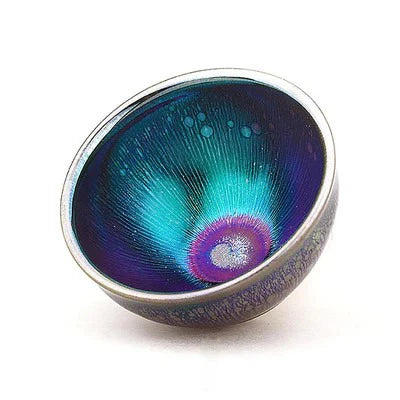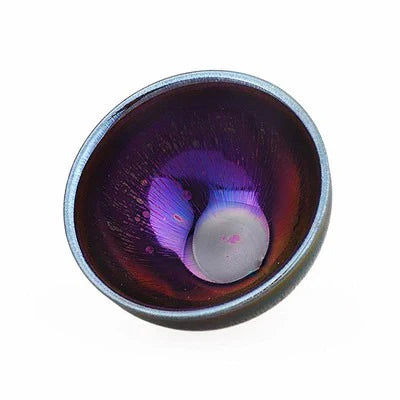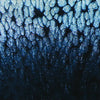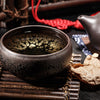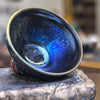TENMOKU AND JIAN ZHAN: EXPERT INSIGHT
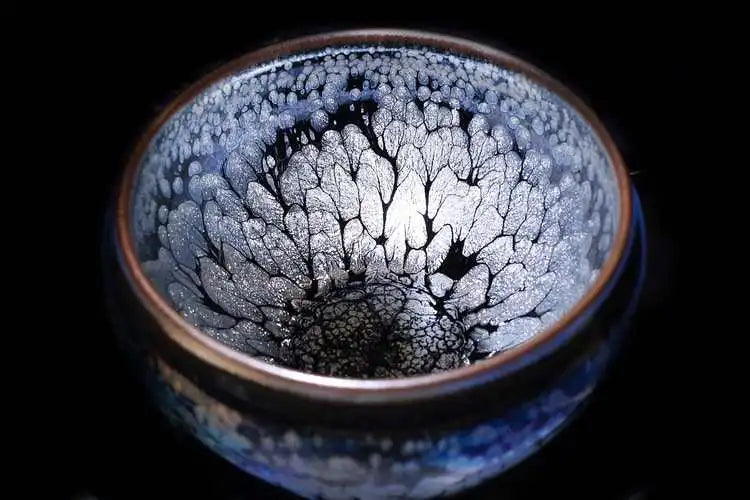
Jian Zhan, also known as Jian Ware, originates from Jianyang, China, and is a distinctive type of Chinese pottery. In Japan, it is referred to as 'Tenmoku'. While various forms of Jian Zhan pottery exist, bowls and cups stand out as the most popular crafted items. The allure of these cups lies in their rich, dark glaze adorned with captivating 'special effects.' Achieved through high-temperature firing, the glaze crystallizes, giving rise to intricate patterns such as stripes, feathers, or oil spots.
This article delves into the historical origins of Tenmoku, exploring its evolution, the craftsmanship behind cup production, and the potential enhancements it brings to your tea-drinking experience.
Jian Ware: Unveiling Historical Significance
With roots tracing back to the Tang Dynasty (618 to 907), Jian Ware rose to prominence during the subsequent Song Dynasty (960–127). While the Tang era witnessed the preparation of tea from tea cakes, with an emphasis on appreciating the subtleties in light-colored tea ware, a significant shift occurred during the Song Dynasty.
The transition to 'whipped tea' marked a pivotal moment. Compressed tea cakes evolved into powdered form, whipped into a thick broth within large bowls or tea cups. This transformative practice gave rise to the preference for sizable and dark Jian Zhan tea cups. These cups, characterized by their depth of color, aligned seamlessly with the intense hue of the whipped tea, becoming an integral element of the evolving tea culture during the Song Dynasty.
Evolution of Jian Zhan Tea Cups: A Transition Through Time
As early as the Yuan Dynasty, the allure of Jian Zhan tea cups began to wane, influenced by the gradual dominance of the 'steeped tea' concept, a departure from the erstwhile tradition of whipped tea.
Fortunately, in the last decade, Chinese ceramic artists have embarked on a journey to revive the artistry of Jian ware. This revival breathes new life into the craftsmanship of Jian cups, steering away from the conventional and exploring a spectrum of colors. Contemporary artisans experiment with diverse material specifications for glazes and varying firing temperatures, resulting in a diverse array of Jian cups.
Notably, the resurgence of Jian ware extends beyond historical boundaries, with Tenmoku cups now finding a place in the world of loose leaf teas. This adaptation reflects a harmonious blend of tradition and modern preferences, ensuring the continued relevance and appreciation of Jian Zhan tea cups in today's tea culture.
Jian Zhan vs. Tenmoku: A Tale of Names
The journey of tea culture transcended borders as Japanese monks introduced powdered tea, known as 'Matcha,' to Japan. In parallel with this cultural exchange, the Japanese began producing their own version of Jian Ware, affectionately naming it 'Tenmoku.' Consequently, two distinct terms emerged to describe these cups, reflecting the unique characteristics and cultural adaptations associated with each.
The coexistence of Jian Zhan and Tenmoku underscores the cross-cultural influence and the ability of tea traditions to evolve. While Jian Zhan has its roots in Chinese history, Tenmoku, born from the Japanese interpretation of Jian Ware, embodies a fusion of traditions. Today, these terms stand side by side, each carrying its own historical and cultural significance in the realm of tea.
Jian Zhan Tea Cup Process: How is Tenmoku made?
Material Selection & Preparation in Jian Ware Craftsmanship
The foundation of exceptional Jian Ware lies in meticulous material selection and preparation. Both the glaze and clay demand a high iron content, a criterion met by the natural resources of Jianzhou, which consequently became the epicenter for this distinct pottery. During the Song Dynasty, attempts by other regions to replicate the quality of Jianyao’s cups were futile due to the lower iron content in their local ore.
The chosen materials undergo a rigorous process of crushing and sieving to attain a judicious thickness. The resulting clay slurry and glaze are then stored in a controlled environment with regulated humidity and temperature. Today, advancements in technology make the crushing process more efficient, yet the artist's vigilance remains crucial to ensure uniformity and prevent cracking during firing.
Shaping and Firing the Base
Once the clay is prepared, it undergoes kneading to eliminate air and enhance density. Handcrafted on a turning table, tea cups take shape under the skilled hands of the artist. This labor-intensive process, though time-honored, ensures each cup is unique, reflecting the artisan's dedication to preserving the traditional craftsmanship of shaping and firing the base.
Afterwards, a small knife/tool is used to modify and perfect tea cup. Once the glaze is applied, it will be put into an oven and fired at a temperature around 1300ºC (2370ºF). It's said that firing the oven using pinewood offers the best effect.
Once the glaze is applied, it will be put into an oven and fired at a temperature around 1300ºC (2370ºF). It's said that firing the oven using pinewood offers the best effect.
Precision in Firing: Crafting with Exactitude
The temperature during firing becomes a critical parameter, subject to slight adjustments based on the specific glaze type and the desired crystallization effects envisioned by the artist. This intricate process, akin to an exact science, demands meticulous attention, as a variance of a few degrees can dramatically alter the final outcome. Notably, the art of Jian Zhan involves a delicate dance of temperatures, where nuanced adjustments contribute to the emergence of unique patterns and colors in the crystallization process.
An intriguing facet of this craft lies in the occasional discovery of new patterns and colors, often stemming from unintentional mistakes in glaze blending or variations in oven temperatures. These unplanned occurrences add an element of serendipity to the artistry, unveiling unexpected beauty born from experimentation.
Upon the completion of the firing process, the artist assumes the role of a discerning curator, carefully examining the quality of each individual cup. Cups that bear cracks or imperfections, no matter how minor, are deemed unworthy and respectfully disposed of. This commitment to quality control ensures that only the finest, flawless Jian Zhan tea cups make their way to tea enthusiasts, preserving the legacy of this ancient art form.
The cups that pass the quality inspection will be divided into different grades and sold to tea enthusiasts.
When you order Jian Zhan from GOSHLE, you'll be assured that:
- We never ship you a faulty Jian Zhan cup. These will be filtered out during our procurement process.
- The measure of the cup will only differ by only +/- 3mm (0.12in) relative to the specified measures on the product page.
- The glaze fully covers the inside of the tea cup. The base cup surface is not visible.
- The glaze on the inside and the outside don't have holes.
- The glaze and its crystallization is considered to be of great quality by our Jian ware experts.

